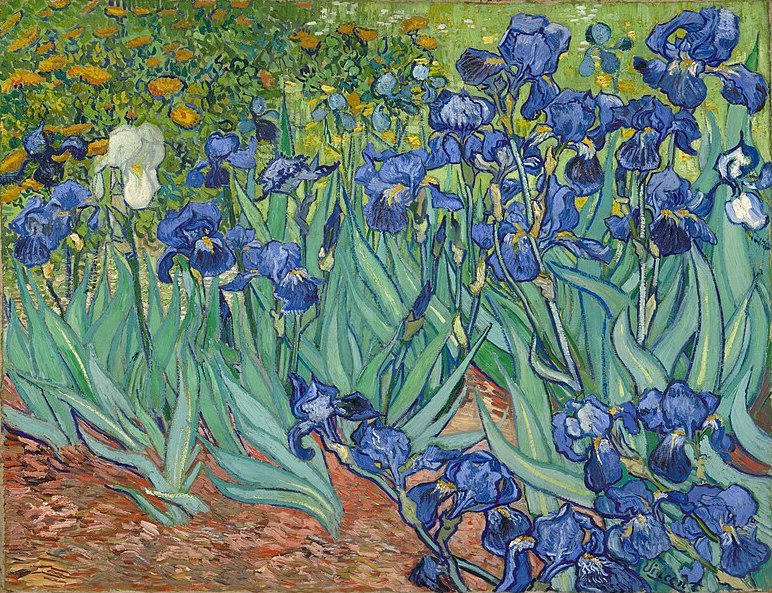
Irises, 1889
Vincent van Gogh’s "Irises" is a radiant and expressive painting that highlights his mastery of color, form, and movement. Painted in 1889 during his stay at the Saint-Paul-de-Mausole asylum in Saint-Rémy-de-Provence, France, this work reflects a period of intense creativity and mental strain in the artist's life. Van Gogh checked himself into the asylum following his infamous breakdown, but it was here that he found solace in nature, especially in the asylum’s gardens, which became a profound source of inspiration for his work.
"Irises" features a large, vibrant cluster of iris flowers, painted with rich, flowing brushstrokes and deep, emotive colors. The flowers, predominantly in shades of blue-violet, stand tall against a background of lush green foliage and warm yellow-orange soil. This striking contrast in colors creates a vivid visual effect, a hallmark of Van Gogh’s post-Impressionist style. The painting is not simply a study of flowers but an exploration of the life force and energy Van Gogh saw in nature. Each iris seems to move and breathe, twisting in dynamic, organic shapes that feel alive with vitality.
Van Gogh was inspired by Japanese ukiyo-e woodblock prints, and this influence is visible in "Irises" through his use of bold outlines and the flattened perspective. The arrangement of the flowers, each one distinct yet harmonious within the composition, speaks to the artist’s appreciation for the natural world’s complexity and beauty. Van Gogh’s love for color theory is on full display here, with the complementary hues of purple and yellow vibrating against one another, drawing the viewer’s eye around the canvas in a continuous, rhythmic motion.
What makes "Irises" especially unique within Van Gogh’s oeuvre is the sense of calm and control it conveys, contrasting with the emotional turbulence often associated with his other works. While the artist’s mental health was fragile at this time, "Irises" offers a glimpse into his moments of clarity and peace. The structured composition and the careful attention to detail suggest that Van Gogh found great comfort in painting the natural world around him.
One iris in the foreground, painted in a stark white, stands apart from the rest, providing a subtle focal point within the sea of color. Some art historians have speculated that this lone white iris represents Van Gogh himself, set apart from others, hinting at his feelings of isolation and uniqueness.
When Van Gogh created "Irises", he was deeply influenced by his admiration for nature’s cycles of life, growth, and renewal. These themes resonate throughout the painting, symbolizing the artist’s hope for healing and personal transformation during his time at the asylum. The work was never intended for exhibition; instead, Van Gogh viewed it as a study, a means of practicing his art and finding peace in the process. Nevertheless, "Irises" has become one of Van Gogh’s most celebrated paintings, renowned for its vibrant energy and emotional depth.
Today, "Irises" is housed in the J. Paul Getty Museum in Los Angeles, where it continues to captivate audiences with its dynamic brushwork, radiant color palette, and Van Gogh’s deep connection to nature. The painting stands as a testament to the healing power of art and nature, as well as Van Gogh’s enduring genius in transforming simple subjects into profound works of emotional resonance.
Through "Irises", Van Gogh invites us to appreciate the beauty and complexity of the natural world, while also reflecting on the delicate balance between fragility and strength—qualities that are mirrored in the artist’s own life.
